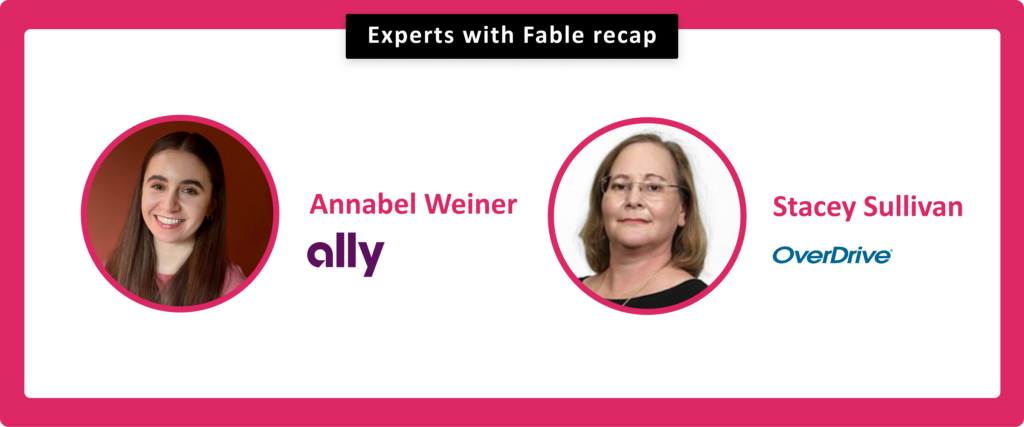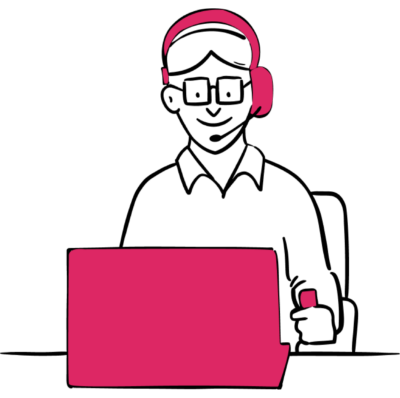
UX researchers at Ally Bank and OverDrive on why they shifted from accessibility guidelines to usability for all
Experts with Fable Recap: Best practices for user research with assistive technology users
Experts with Fable is an ongoing webinar series where UX designers, researchers, product managers, engineers and accessibility professionals from leading companies discuss their digital accessibility projects, lessons, and strategies. To stay in the loop about future Experts with Fable, follow us on LinkedIn and Twitter.
In our latest edition of Experts with Fable, Elana Chapman, Accessibility Research Manager at Fable, sat down with Stacey Sullivan, UX Team Lead at OverDrive, and Annabel Weiner, User Experience Accessibility Specialist at Ally Bank to discuss their experiences with accessibility as user researchers.
Annabel and Stacey both complete accessibility and usability testing and research with assistive technology users with disabilities within Fable’s community of testers. Assistive technologies can include screen readers, screen magnification, or alternative navigation devices.
Annabel and Stacey shared their perspectives on why they push past WCAG to provide an even better user experience for all and best practices for user research with assistive technology users. They further discuss their strategies for getting organizational buy-in for accessibility projects.
Could you tell us about you, your role, and what inspired you to start doing accessibility research?
Annabel: I’m Annabel Weiner (she/her), a User Experience Accessibility Specialist at Ally Bank. Accessibility is one of the reasons I was really excited about working at Ally as they have a large focus on making products accessible and inclusive.
Doing user research with people with disabilities, being able to learn from them, and co-design with them is my favorite part of my role.
Stacey: Hi, I’m Stacey Sullivan (she/her). I am a UX Team Lead at OverDrive. We have multiple apps. The one that we’re most known for is Libby, which allows you to borrow eBooks and audiobooks from your public library. We’re available in 22,000 libraries across the world.
Making sure reading and libraries are accessible is my greatest quest. We’ve been working with Fable for a little over a year working with many different assistive technology users.
Where are your teams currently on their accessibility journey?
Annabel: Ally’s accessibility program is mature; it’s been around for about seven years. Our job is to make sure all our customer experiences on our website and mobile app meet the Web Content Accessibility Guidelines (WCAG).
We also aim to push past WCAG to provide an even better user experience for people with disabilities. Our team lays out the framework for accessibility and ensures every member of our digital team is trained in introductory accessibility concepts.
Accessibility starts during the design phase, so we ask all our designers to make sure their projects consider accessibility and have accessibility annotations. We also have an accessible design system. Meaning, each component in our design system has been built to be accessible and tested for accessibility with assistive technology. Now with Fable, we’ve been able to start testing these components earlier with assistive technology users.
After a project is developed, our testing team conducts automated and manual testing such as manual screen reader testing, keyboard testing, and axe testing.
Stacey: OverDrive has been creating accessible products for many years. This has been a big focus for our apps: Libby and Sunset. A lot of our research prior to this was more with users who would ask for tech support, call with questions, or talk to librarians about us.
We started really getting into making Libby accessible when our developers expressed interest in hearing directly from users with disabilities and watching them using our product. That’s when we started with Fable.
What challenges have you run into in your accessibility work and how have you overcome them?
Annabel: The CX team at Ally has conducted studies with people with disabilities in the past. But it’s been hard to recruit for those on your own. We used to rely on our relationships with community partners locally to recruit.
But even that was time-consuming and something we only were able to do once a year or so. Fable has really helped us by expediting and handling the recruiting aspect.
When you look at the stats, about 1 in 6 people in the US have a disability. That’s something that should be reflected in our research. Fable has helped us take a lot of those recruiting difficulties out of the picture so we can easily select what kind of tests we want to run.
We’re now able to do more early research with people with disabilities and catch those issues earlier in the process instead of when something’s in development. This saves us a lot of time.
Usability testing with people with disabilities has played a huge role in helping us expand our research and inclusive design practices.
Stacey: Sometimes screen magnification needs, and screen reader needs aren’t necessarily the same. It’s really a balancing act about what is the bigger need. Often if you examine competing or contradictory needs, you’ll see one is a frustration and the other is a real need. Fable testing really helps us determine that.
How has conducting research with people with disabilities impacted your organization?
Stacey: We used to be really focused on trying to meet WCAG standards. It was challenging as nobody knew how to test for those standards, nobody knew how exactly the screen reader user thinks or how a screen magnification user struggles with different things.
Now that we complete usability testing with people with disabilities, we can watch users go through certain flows and even participate in testing.
We can now easily understand what needs to be updated, what works, and what is not usable.
We can incorporate those learnings into our daily practices which has really made a big difference to our team. Fable has been a great partner for us.
Annabel: I’ll add that being able to share video clips of Fable testers using certain flows on our site and app has been extremely helpful for our team.
We used to tell developers on our team, “hey there is this is WCAG guideline, and this is how you should do it.” But having a clip of someone using assistive technology to illustrate the issue and put the guideline in perspective for a real user has been very impactful for the whole digital team.
Stacey: The things that clips have done for our team is threefold. What it does is for somebody who’s so busy trying to do 52 other things is get to the core of the problem. It gets to the problem in a way that someone can identify it, solve it and go back to it as well.
Have you been able to get buy-in for accessibility from other teams? If so, what tips do you have?
Stacey: Absolutely. We have members across our development, QA, tech support, and tech writing teams that are very excited about and interested in accessibility. They all want to watch our Fable tester videos. So, it’s really permeating throughout the company.
Fable did an accessibility Lunch and Learn where they shared some actual clips from our own research. Sam Proulx (Fable’s Accessibility Evangelist) who uses a screen reader explained when you’re doing automated testing for accessibility, the tool will tell you to insert something here and then say it’s accessible. But it really isn’t.
So, the team was able to see that combining usability testing with people with disabilities with automated testing just makes our process so much stronger.
Our accessibility testing with Fable is ongoing and continuous throughout any given month. So, we can continue with testing and show the value of accessibility. That’s part of the real beauty of what we get from Fable.
Annabel: We’ve been doing presentations for teams about the benefits of usability testing with people with disabilities for our UX and product management teams. It has been great to share usability test findings that we’ve done with people with disabilities with teams, and even share relevant findings with teams working on a different project that has a similar design or component.
Having the awareness of the impact of Fable as a resource and making sure teams know they can use it or ask to use it has been great for our teams.
We also combine our findings from our research with Fable into our findings with overall CX research. We’ve been using Fable for accessibility feedback, but also overall usability feedback. So, when we deliver report outs, we’re providing accessibility and usability feedback from people with disabilities along with usability feedback from other platforms the CX team uses all in one package.
This helps ensure accessibility is not regarded as an add-on or something that comes after the fact of a project.
Has anything surprised you as you started to get into your accessibility journey?
Stacey: Two things. When I started with accessibility I thought “I have no idea what I’m doing.” I’ve been in the UX market research world for decades and I’ve done a lot of focus groups and in-depth interviews, but this is a whole new world.
What I learned was accessibility and usability for people with disabilities really isn’t as far of a leap from our standard practices as I expected it to be. I remember thinking “oh, this really isn’t that far off from my usual practice.”
There are a lot of automated tests or checks people think will make their products accessible, but without testing with a real person with a disability who uses an assistive technology you won’t ever really know.
Annabel: For me, it was surprising to see the experiences of different kinds of assistive technology users. You’re never going to be able to catch everything that could be inaccessible for an assistive technology user since we just don’t live it every day.
Our team had been really focused on screen reader accessibility, which is super important. But we’ve learned a ton from people with low vision who use screen magnification and speech-to-text users.
It’s been helpful to make sure we’re testing with different types of assistive technology users.
What’s some of your key accessibility learnings that you want people to go away remembering?
Stacey: I would say two things. Think about screen magnification and speech to text users as well as the screen reader user. They think completely differently. We often think about WCAG standards with screen readers in mind, but screen magnification users have just as much trouble and have many challenges.
Annabel: We’ve learned a ton about screen magnification users with Fable. Also, findings for one project are often applicable to others. You don’t always need to test everything. If you find something doesn’t work for someone using screen magnification when there’s an element on the page that’s too far to the right, that finding can be applied on a project with a similar design.
You can do all the accessibility checks you want but it’s not going to replace talking to people who experience it every day. I’m never going to be able to catch every accessibility issue. So, I think being able to have that collaborative co-design relationship with Fable testers, that’s been instrumental for us.
Watch full webinar to learn more from Annabel and Stacey
Start usability testing with people with disabilities
Questions about how you can bring people with disabilities into your product design and development cycle to improve user experiences for all?

